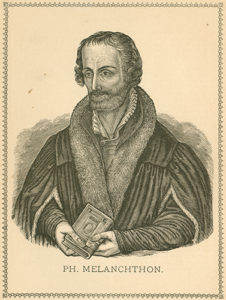by Rev. Dr. Jason Lane
 Locus is the Latin word for “place”. Loci are places. And Loci Communes are common places where one may like to put things, either in the mind or in a book—organized, as if in a physical location, and easy to retrieve when needed. Many, including the ancients (and even Sherlock Holmes) have described these places as rooms in the mind or a “mind palace.” The loci method is an ancient method of memory that Philip Melanchthon and many other classically trained humanists learned at a young age. He applied this art of memorization and organization to learning the Scriptures by heart. Melanchthon was the first Lutheran to use the loci method to organize the major teachings of Scripture. But anyone familiar with the Small Catechism knows that biblical teaching can be organized into theological loci. In the Catechism, almost every passage, chapter, and verse of Holy Scripture can be collected under either a command, article, petition, or sacrament. Luther knew it and so did Melanchthon.
Locus is the Latin word for “place”. Loci are places. And Loci Communes are common places where one may like to put things, either in the mind or in a book—organized, as if in a physical location, and easy to retrieve when needed. Many, including the ancients (and even Sherlock Holmes) have described these places as rooms in the mind or a “mind palace.” The loci method is an ancient method of memory that Philip Melanchthon and many other classically trained humanists learned at a young age. He applied this art of memorization and organization to learning the Scriptures by heart. Melanchthon was the first Lutheran to use the loci method to organize the major teachings of Scripture. But anyone familiar with the Small Catechism knows that biblical teaching can be organized into theological loci. In the Catechism, almost every passage, chapter, and verse of Holy Scripture can be collected under either a command, article, petition, or sacrament. Luther knew it and so did Melanchthon.
We use the loci method every day because it’s so natural to the mind. If we want to remember something, we have to put it away so we can find it later. We do this with physical object and we also do it with mental objects. Where did you put your keys? It’s a physical place, around the wall from the dining room and into the kitchen, to your right, on the counter. We retrace our steps. Loci are meant to link knowledge visually to physical locations. Melanchthon used this method to organize a body of biblical knowledge in a book by putting important topics (topoi, another name for “place”) or articles into their own place.
In my English Bible, Romans 3:21 is on the left-hand page, all the way down: “But now the righteousness of God has been manifested apart from the law…” I don’t need my Bible to see it. I can picture it, every word. But there are other verses that say something similar, and I want to keep them together in one place in my mind: “Behold, now is the favorable time; behold, now is the day of salvation” (2 Cor. 6:2) and “In him we have redemption through his blood, the forgiveness of our trespasses…which he lavished on upon us…making known to us the mystery of his will, according to the purpose, which he set forth in Christ as a plan for the fullness of time, to unite all things in him, things in heaven and things on earth” (Eph. 1:9-10). For Christians to know the clear biblical teaching, they need constellations, not just one or two wandering stars. Melanchthon’s Loci Communes gives us constellations of biblical teaching by organizing Christian doctrine into eleven major loci. A star may be bright and beautiful, just as Romans 3:21 shines brightly about the righteousness of God, but a constellation shines with even greater clarity. Even if some of the passages are not as clear to us as we would hope, a collection of passages, each passage understood in relation to the others and interpreting each other, rises like Hercules on a summer’s night.
In 1521, when his Loci Communes were published in Wittenberg, Melanchthon was only 24-years old. The book (now ably translated into English by Christian Preus and available from Concordia Publishing House, 2014), consisted of eleven constellations of Christian doctrine that, for most part, followed St. Paul’s outline of Christian doctrine in the Epistle to the Romans. Luther was so pleased with it that he suggested Melanchthon’s Loci should be included in the canon of Scripture. Melanchthon’s division is as follows:

- 1. Concerning Human Virtue and Free Will
- 2. Concerning Sin
- 3. Concerning the Law
- 4. Concerning the Gospel
- 5. Concerning Grace
- 6. Concerning Justification and Faith
- 7. Concerning the Distinction between the Old and New Testaments and Abolishment of the Law
- 8. Concerning Signs
- 9. Concerning Charity
- 10. Concerning the Magistrates
- 11. Concerning Scandal [Adiaphora]
In the later additions of the Loci, Melanchthon expanded the topics to cover more doctrine. Although these editions were better surveys of Christian doctrine, he shifted emphasis on some of the central teachings that made his first attempt worthy of the canon. For example, Melanchthon included in these later editions a more optimistic view of the human will’s role in conversion, placed a heavier emphasis on the third use of the law (which required adjustments in the Formula of Concord, Article VI), and abandoned Luther’s confession of the Lord’s Supper. Large portions of Melanchthon’s later work can be found in Martin Chemnitz, Loci Theologici in 2 volumes from Concordia Publishing House.
Melanchthon’s use of the loci method to teach and confess the faith is one of his greatest contributions to the Lutheran Church. Whatever errors followed in the later editions of his work, his 1521 Loci Communes came to their fullness at Augsburg in 1530. The loci method would become in the Lutheran Church the high standard for learning, teaching, and confessing the Christian faith among young and old, simple and learned, and preachers and hearers. If the 500th anniversary of the Reformation leads us to discover the great dogmatic tradition of the Lutheran Church, it is only fitting that we begin with Melanchthon in 1521.
The Rev. Dr. Jason D. Lane is Assistant Professor of Theology at Concordia University Wisconsin in Mequon, Wis.
